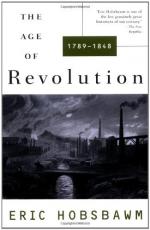
|
| Name: _________________________ | Period: ___________________ |
This test consists of 5 multiple choice questions, 5 short answer questions, and 10 short essay questions.
Multiple Choice Questions
1. What is the paradox in France's failure to develop its industries?
(a) The peasants had more autonomy as a result of land reforms, but they were not well positioned to capitalize on their land.
(b) The peasants gained more political power, but with so many voices, the government was paralyzed.
(c) The workers became more efficient, but the cost of living skyrocketed.
(d) The aristocracy lost the land, but retained the right to what the land produced.
2. What began to emerge as production and industry grew in the early 1800s?
(a) Suburbs.
(b) Industrial centers.
(c) An international slave trade.
(d) Religious persecution.
3. In what way did conservative thinkers resist middle class ideology?
(a) By appealing to history and tradition.
(b) By advocating for international trade.
(c) By inciting revolutions to revert to ancient values.
(d) By studying ancient cultures.
4. What possibility did this social structure open to French society?
(a) It became a place where the monarch could appoint friends and supporters.
(b) It became a place where talent could succeed regardless of wealth or birth.
(c) It became a place where new immigrants could attain citizenship.
(d) It became a place where aristocrats could regain their property and standing.
5. What was changing in the role religion played in people's lives, in Hobsbawm's account?
(a) It was expanding into poor neighborhoods.
(b) It was in general decline.
(c) It was becoming merely ceremonial.
(d) It was becoming more radical.
Short Answer Questions
1. What view of society was beginning to be adopted widely, in Hobsbawm's account?
2. What landmark event does Hobsbawm see as the peak of the middle class ideology?
3. Which form of rebellion did the working poor NOT engage in?
4. According to Hobsbawm, what characterized conditions in the neighborhoods of the working poor?
5. What changed in other countries, but did not change in France, in Hobsbawm's analysis?
Short Essay Questions
1. What does Hobsbawm say were the three paths a working class person could choose in 1848?
2. What does Hobsbawm say was the third kind of secular thought that developed during the middle of the nineteenth century?
3. How did those in power react to the spread of middle class ideology, in Hobsbawm's account?
4. Which artist does Hobsbawm cite as examples of the high standards reached in the arts in the mid-1800s?
5. How does Hobsbawm describe the class tensions surrounding the new middle class?
6. Who does Hobsbawm say was most receptive to Romanticism, and why?
7. What does Hobsbawm say was growing along with and as a result of Protestantism?
8. What happened in France while the rest of Europe was industrializing?
9. Why were Jews and Protestants in particular successful and socially mobile, in Hobsbawm's account?
10. What role did religion serve, even as Europe was becoming more secular?
|
This section contains 862 words (approx. 3 pages at 300 words per page) |

|




